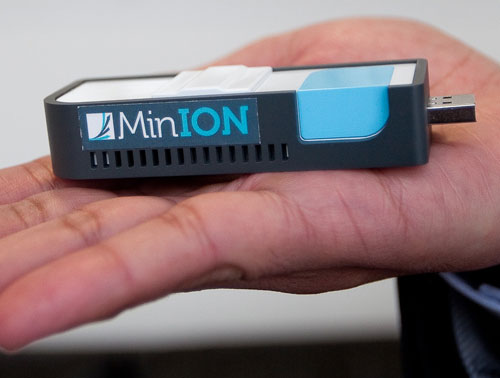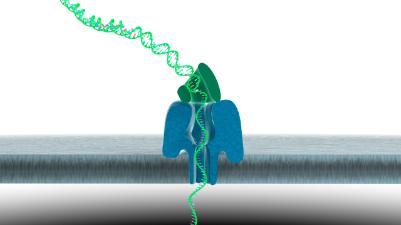
GridION uses unique pores made of the protein α-hemolysin from the bacteria Staphylococcal to sequence DNA by threading DNA through the pores. These pores are
embedded in a lipid bilayer. Many of these pore-complexes can then be used in an array of microwells. (34)
The MinION USB DNA sequencer utilizing the GridION technology will mark a major milestone in DNA sequencing technology, becoming one of the first DNA sequencers to sequence DNA for a retail price under $1000. Oxford Nanopore claims it will be able to sequence an entire genome in 15 minutes in one continuous read. (19) The image to the left shows a long DNA strand being sequenced by a single nanopore. |
The diagram above explain the theory behind nanopores. When each different sized molecule is placed across the nanopore, each molecule blocks the current in a particular way, resulting in a unique current drop for each molecule which can be measured.
- The GridION pore is actually made of the protein α-hemolysin (that's the Greek letter alpha) from the bacteria Staphylococcal, and it is embedded in a lipid bilayer. Many pores can be embedded in an array of microwells.
- An ionic current is set to flow across the pore by causing a voltage difference across the membrane.
- Then, DNA is threaded across the nanopore at a rate of about one nucleotide per millisecond.
- As each nucleotide crosses the nanopore, each nucleotide partially obstructs the current, causing a measurable drop in the current, and each nucleotide causes a different current drop. If you don't understand this, think of the current as water flowing across the nanopore, and the nucleotides as four different-sized rocks. When a rock is placed near the nanopore, it will block part of the water flowing and cause the amount of water entering to drop. Since each rock is a different size, each rock will cause the water flow to drop by a different amount. (34)
Since these protein nanopores can be unstable and hard to use, new solid-state, or artificial, nanopores are being developed by Oxford Nanopore. In collaboration with several labs from Harvard University, researchers are developing new nanopores made from graphene, a one-atom layer of carbon which forms the thinnest known membrane. (37)



